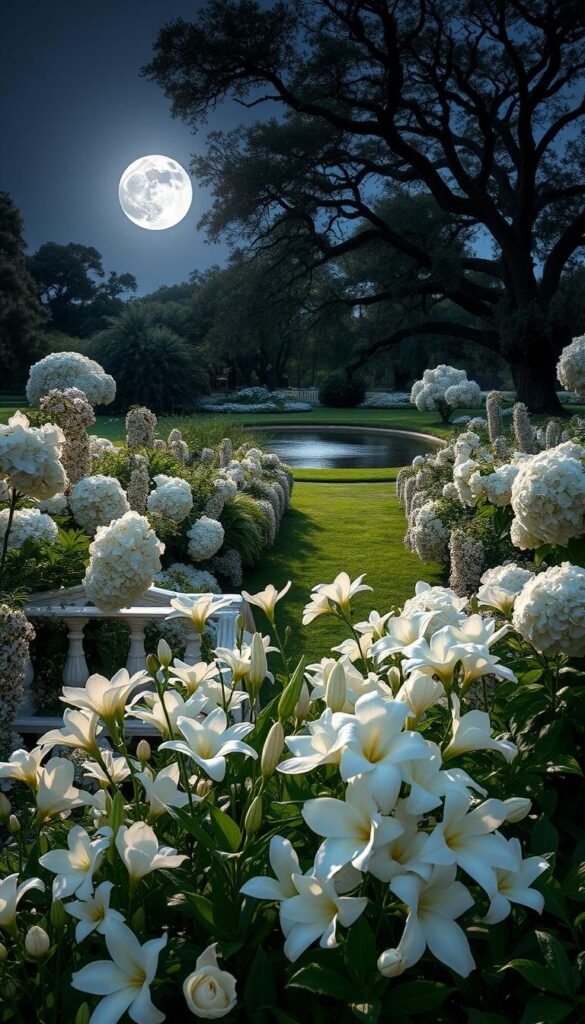When daylight fades, a new kind of beauty awakens. Night-friendly landscapes offer more than just visual charm – they create multi-sensory experiences that engage sight, smell, and imagination. Unlike traditional plots that lose their color after sunset, these spaces come alive under celestial light.
Southern gardeners have long embraced evening-focused designs to escape daytime heat. Cooler temperatures make twilight hours perfect for enjoying nature’s softer side. Pale petals act like natural reflectors, catching every glimmer from the sky while releasing sweet fragrances after dark.
What makes these arrangements truly special? Their ability to transform ordinary yards into dreamlike retreats. Silver-toned foliage shimmers beside blossoms that seem to float in the darkness. This creates depth and movement where other plants disappear at dusk.
You’ll find these luminous landscapes work year-round, offering structure in winter and delicate beauty in warmer months. They extend your outdoor enjoyment time while creating memorable spaces for relaxation or entertaining under the stars.
Understanding the Magic of Moon Gardens
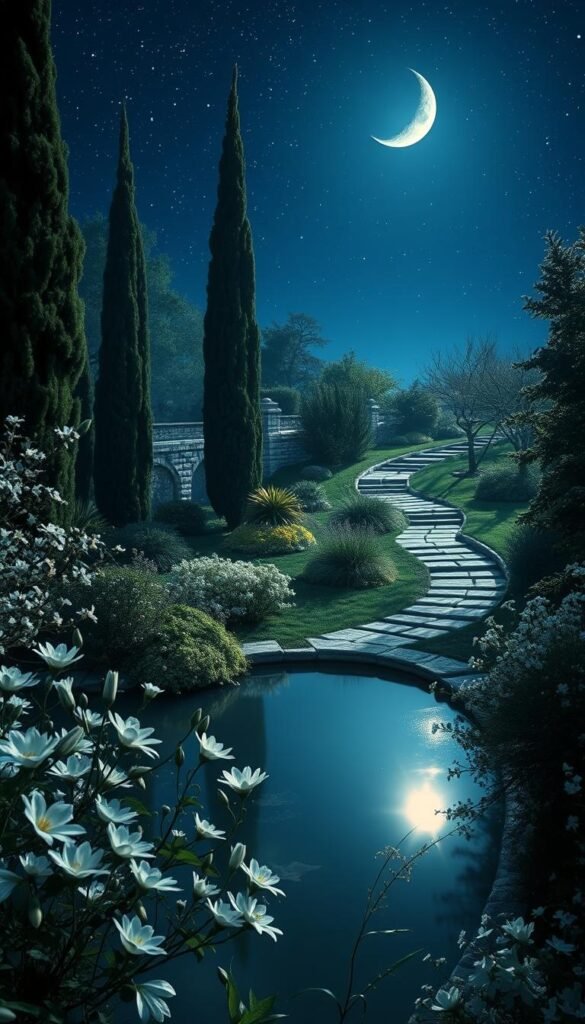
Dusk brings a transformation where shadows dance with silvery whispers. Unlike daytime displays, these arrangements use nature’s own reflectors to craft living art after sunset. The secret lies in petal chemistry and clever light play.
How Moonlight Transforms Your Space
Sunset doesn’t mean your outdoor area loses charm – it gains new dimensions. Pale petals contain microscopic structures that scatter moonlight 3x more effectively than colored blooms. This creates floating shapes that seem to hover in darkness.
“Night gardens don’t compete with daylight beauty – they rewrite the rules of landscape design.”
Consider these twilight transformations:
| Feature | Day Effect | Night Magic |
|---|---|---|
| Petal Colors | Compete for attention | Unified glow |
| Foliage | Green backdrop | Silver highlights |
| Fragrance | Fades in heat | Intensifies at dusk |
The Allure of Silvery Blooms
Some blossoms perform fleeting midnight shows. Evening primrose unfurls at twilight, while night phlox releases perfume when stars appear. These temporary wonders make each viewing feel exclusive.
Textured leaves amplify the effect. Lamb’s ear foliage catches stray light beams like nature’s sequins. Combined with pale petals, they create depth that daytime plantings can’t match.
This approach isn’t just pretty – it’s practical. Reflective surfaces help you navigate paths safely while attracting beneficial pollinators that work after dark.
Benefits of a White Flower Garden Elegance Setup
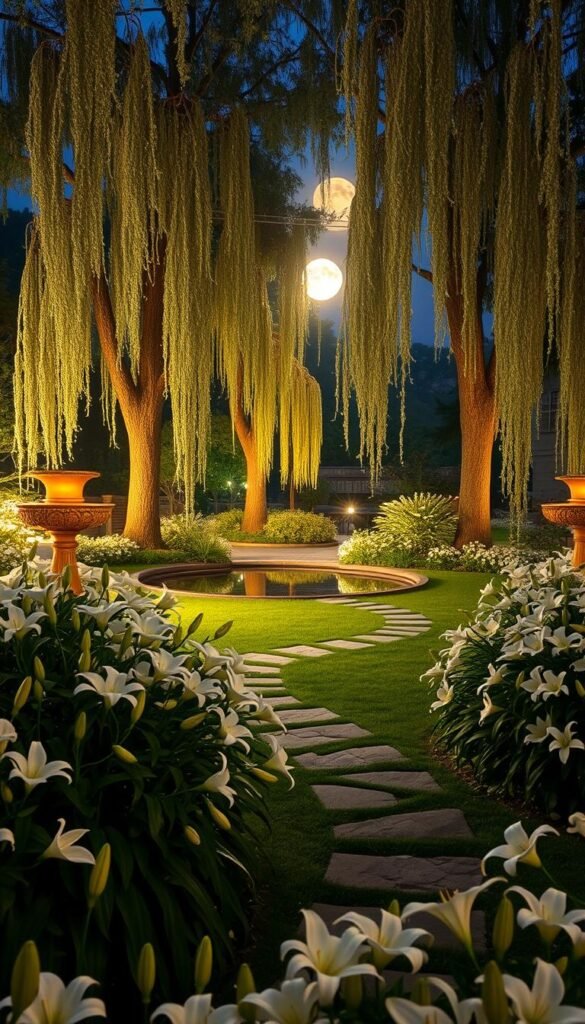
Your busiest hours might align perfectly with these blossoms’ peak performance. Early risers catch dewdrops clinging to petals at dawn, while night owls enjoy fragrant shows after sunset. This timing syncs with when you’re most likely to relax in your outdoor space.
Cooler evening temperatures unlock hidden scents in night-blooming varieties. Imagine jasmine-like perfume wafting over your patio as daylight fades – nature’s stress-relief treatment without candles or diffusers. These aromas grow stronger as humidity rises, creating sensory magic during twilight hours.
“My dinner parties moved outdoors once I framed the seating area with moonlit blooms – guests stay later now”
Strategic placement near gathering spots multiplies enjoyment. Consider these advantages:
- Extended outdoor season from spring through fall
- Increased property appeal with unique lighting effects
- Reduced maintenance compared to colorful annuals
Many silvery-leafed plants maintain visual interest even when not flowering. They reflect ambient light from house windows or pathway lamps, ensuring your garden never looks bare. This year-round structure means less replanting and more relaxing.
| Feature | Traditional Gardens | Evening Gardens |
|---|---|---|
| Peak Hours | Midday | Twilight/Dawn |
| Water Needs | High | Moderate |
| Wildlife | Bees/Butterflies | Moths/Bats |
You’ll appreciate how these designs work with your schedule rather than against it. Morning coffee tastes better surrounded by glistening petals, while evening gatherings gain atmospheric charm. All without demanding extra time or complex care routines.
Key Considerations for Planning Your Moon Garden
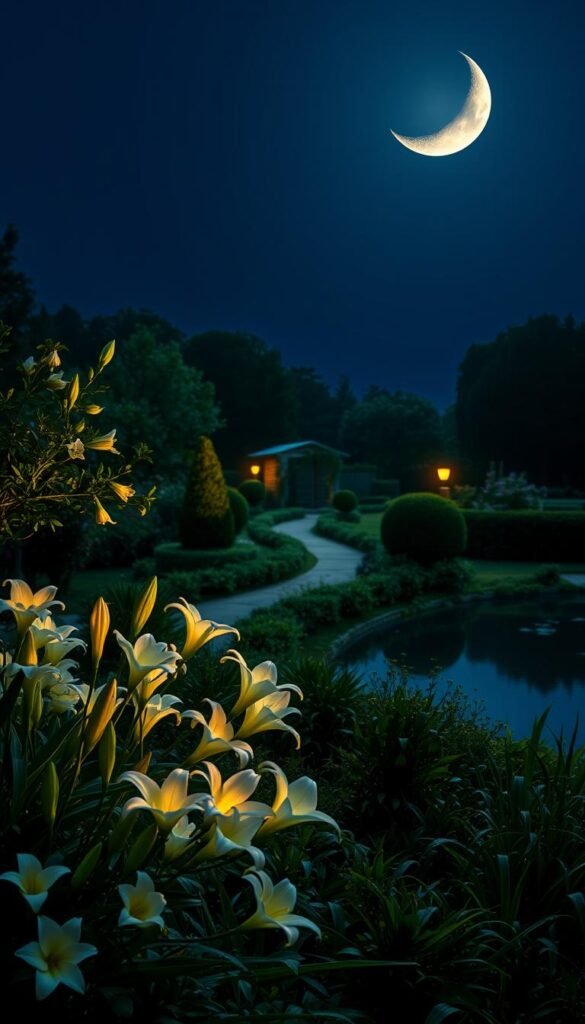
Creating an enchanting nighttime space starts with smart preparation. Your success hinges on matching botanical needs to your environment’s unique features. Let’s break down the essentials for aligning your vision with practical growing conditions.
Choosing the Right Location and Exposure
Sun patterns dictate where your stars will shine brightest. Track how light moves across your yard – some varieties crave morning rays but wilt in afternoon heat. Areas with dappled shade often support delicate blooms that fade under intense sun.
Pro tip: Use a simple sun chart. Note which spots get 6+ hours of direct light versus partial shade. This helps group sun-loving species together while protecting shade-preferring types near structures or trees.
Understanding Your Gardening Zone and Climate
Your USDA zone acts like a plant passport. It determines which perennials survive winter and which annuals need replanting. Check your area’s frost dates to avoid losing tender varieties to early cold snaps.
Local weather quirks matter too. Coastal breezes? Desert dryness? Match plants to these conditions. For example, cold-hardy plants thrive in northern zones, while heat-tolerant picks excel down south.
| Zone Range | Plant Types | Key Features |
|---|---|---|
| 3-5 | Snowdrop Anemone | Frost-resistant |
| 6-8 | Evening Stock | Heat-tolerant |
| 9-11 | Moonflower Vine | Year-round growth |
Don’t forget soil checks. Many pale bloomers prefer well-draining earth. A quick drainage test – dig a foot-deep hole, fill with water – tells you if amendments are needed. Fast drainage? Add compost. Slow? Mix in gravel.
White Flower Garden Elegance: Plants for a Stunning Moonlit Display
Twilight transforms ordinary greenery into radiant landscapes. Our curated list features over 50 varieties that thrive after sunset, from early spring bulbs to winter-blooming shrubs. These selections work together to maintain luminous beauty across seasons.
Smart timing creates nonstop visual interest. Snowdrop bulbs emerge as winter wanes, while summer phlox takes center stage in July. Autumn brings pearly asters, ensuring your space never lacks glowing accents. Pair quick-growing annuals like sweet alyssum with lasting perennials such as Shasta daisies for instant impact and lasting structure.
Layered designs add depth to moonlit views. Low-growing candytuft forms silvery carpets beneath taller nicotiana blossoms. Mid-height options like foamflower bridge the gap between ground covers and towering tree hydrangeas. This vertical variety guides the eye upward while creating natural movement after dark.
“The right plant combinations turn your yard into a living constellation map”
Each species serves multiple purposes. Delicate lily-of-the-valley offers ground coverage and sweet fragrance, while climbing moonflower vines create living curtains of light. Drought-tolerant options like yucca reduce water needs without sacrificing visual appeal.
| Plant Type | Bloom Period | Special Features |
|---|---|---|
| Spring Bulbs | Feb-Apr | Early color bursts |
| Summer Annuals | Jun-Aug | Rapid growth |
| Fall Perennials | Sep-Nov | Cold tolerance |
Your local climate and soil determine which varieties will flourish. Coastal areas favor salt-resistant sea thrift, while inland zones support hardy peonies. Matching selections to your environment ensures thriving displays with minimal effort.
Stunning White Blooms for Late Spring and Early Summer
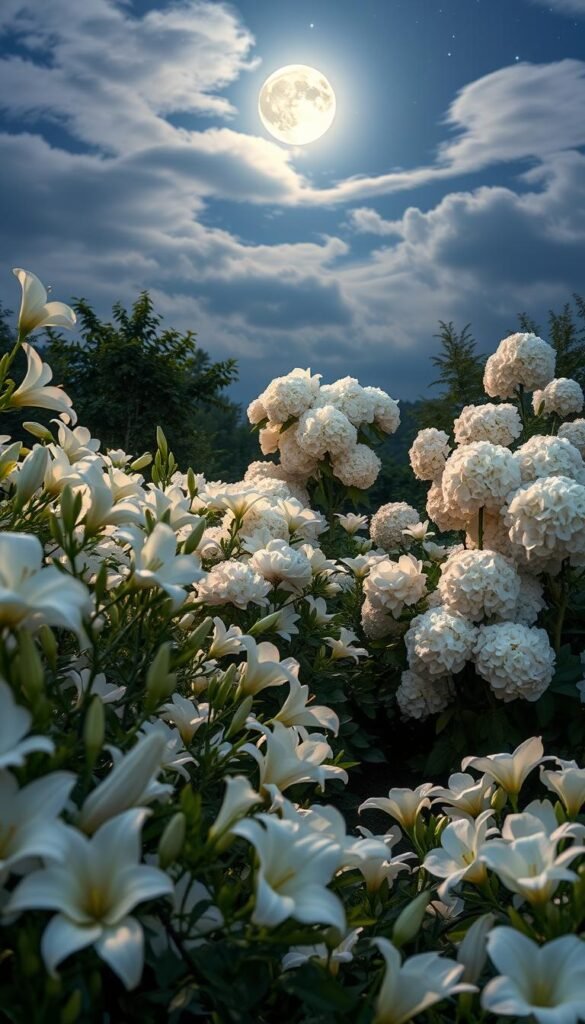
Reliable performers steal the show when temperatures rise. These annuals deliver months of luminous beauty with minimal effort, perfect for busy gardeners craving continuous color.
Durable Annuals and Fragrant Options
Diamond Snow and Diamond Frost lead the pack with nearly indestructible growth habits. Thriving in full sun, they laugh at summer heat while producing clouds of tiny blossoms. One dose of slow-release fertilizer keeps them flowering from late spring until frost.
Sweet Alyssum varieties like Snow Princess offer double rewards. Their honey-like fragrance intensifies at dusk, complementing the visual magic of white and silver plants. Unlike traditional types, these hybrids resist bolting – meaning no deadheading or gap-filled beds.
| Plant | Key Strength | Bloom Period |
|---|---|---|
| Diamond Series | Drought tolerance | May-October |
| Snow Princess | Heat resistance | April-Frost |
| Standard Alyssum | Quick coverage | Spring-Fall |
Pair these champions with taller perennials for layered interest. Their low-growing forms create living mulch that suppresses weeds while reflecting moonlight. You’ll appreciate how they maintain crisp appearances even during July’s scorching afternoons.
New gardeners love their foolproof nature. Established plants handle occasional missed waterings, and pests rarely bother these resilient bloomers. Simply plant, feed once, and enjoy months of carefree elegance.
Unique White Flowers That Glow in Moonlight
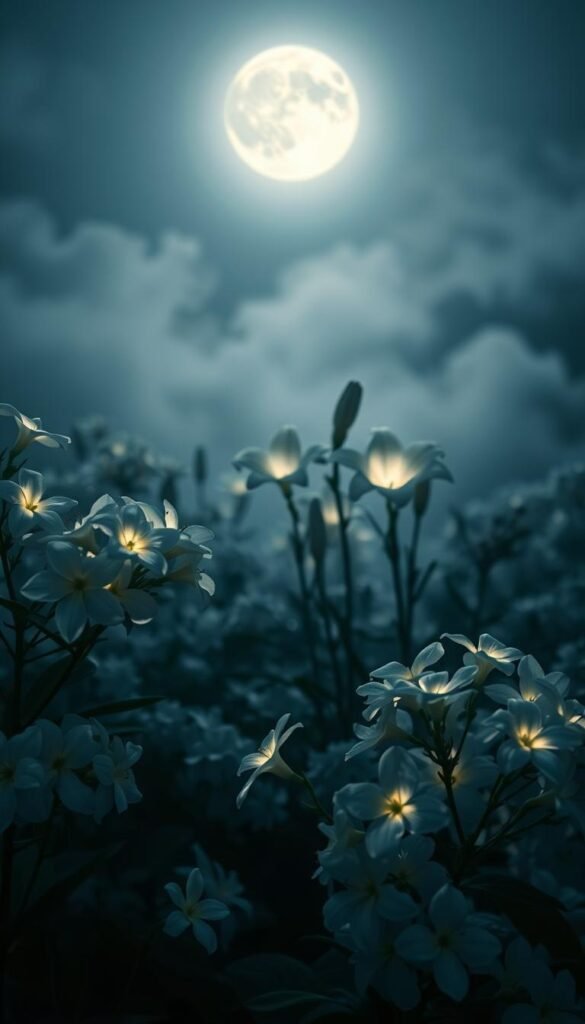
Twilight reveals hidden marvels in your outdoor space. Certain varieties transform after sunset, their petals becoming nature’s own lanterns. These selections combine visual drama with practical benefits, turning containers and beds into radiant focal points.
Nighttime Stars With Dual Personalities
Over Easy calibrachoa delivers daily surprises. Daylight shows butter-yellow centers, while evening unveils glowing petals that spill from containers like liquid starlight. This compact grower thrives in full sun, blooming nonstop from spring through fall.
Superbena Whiteout verbena offers pest-resistant beauty. Its snow-white clusters attract butterflies but repel deer, creating lively yet low-maintenance displays. Plant it where you’ll catch its evening fragrance – near seating areas or along pathways.
| Plant | Day Feature | Night Magic | Bonus Benefit |
|---|---|---|---|
| Over Easy | Yellow centers | Spilling glow | Drought-tolerant |
| Superbena | Compact growth | Butterfly magnet | Deer-resistant |
| White Wonder | Veined leaves | Light reflector | Shade-friendly |
White Wonder caladium works overtime in shaded corners. Its broad leaves with dark veins act as natural light amplifiers, brightening areas that receive minimal direct moonlight. Pair it with taller varieties for layered luminosity.
Position these specimens where their glow matters most. Edge pathways with calibrachoa, frame seating areas with verbena, and use caladiums beneath trees. Their combined reflections create depth that makes small spaces feel expansive after dark.
Night-Blooming Whites and Their Captivating Scents
As twilight deepens, hidden performers take center stage in your outdoor space. These botanical night owls unfurl petals when others sleep, creating living chandeliers that shimmer under moonlight. Their secret weapon? Fragrance that intensifies after sunset, turning your yard into a perfumed oasis.
Angel’s trumpet steals the show with foot-long blossoms that release intoxicating sweetness to attract moths. Each flower lasts 1-3 nights, offering fleeting beauty that feels exclusive. Nearby, Casa Blanca lilies stretch their waxy petals wide, emitting peak fragrance during evening hours that lingers for two weeks.
“My patio becomes a fragrance lounge every summer night – guests think I’m using hidden diffusers!”
Four O’Clocks deliver punctual drama, opening precisely as temperatures drop. Their color-changing blooms pair with subtle spice notes, while evening primrose adds lemony freshness. For maximum impact, night-blooming jasmine unleashes scent trails reaching 500 feet – nature’s perfume cannon.
| Plant | Bloom Time | Fragrance Peak |
|---|---|---|
| Angel’s Trumpet | Dusk to dawn | Midnight |
| Casa Blanca Lily | 7 PM – 10 AM | First 3 nights |
| Night Jasmine | Full darkness | Within 1 hour |
These specialists evolved clever survival tricks. Moth-attracting scents ensure pollination, while temperature-sensitive blooms conserve energy. Place them near seating areas or bedroom windows to enjoy nature’s nightly aromatherapy session.
White Flowers to Enhance Your Summer and Fall Garden
As warm days stretch into cool evenings, your landscape can maintain its luminous charm. Certain perennials bridge the gap between seasons, offering reliable beauty when other plants fade. Their enduring nature makes them ideal for creating seamless transitions in moonlit spaces.
Perennial Picks for Extended Blooms
Firefly Diamond yarrow stands out with ivory clusters that darken gracefully. Its sturdy stems stay upright through summer storms, while contrasting foliage adds depth to twilight views. Pair it with The Price is White echinacea – this drought-resistant star pumps out 5″ blooms from July through October.
Prefer delicate textures? Chantilly Lace goatsbeard unfurls cream plumes in late spring. Unlike fussy astilbes, it thrives in dry spells once established. For nonstop white accents, Amazing Daisies Shasta varieties deliver months of crisp petals. Just snip spent flowers to encourage new buds.
These selections work smarter, not harder. They reduce replanting while providing cutting material for indoor arrangements. Best of all, their reflective qualities shine brightest when you’re most likely to enjoy them – during tranquil evenings under the stars.

